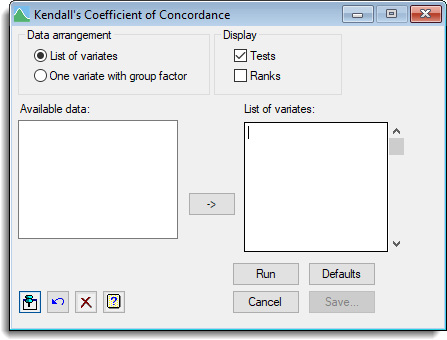Select menu: Stats | Statistical Tests | Kendall’s Coefficient of Concordance
Use this to calculate Kendall’s coefficient of concordance, which is a measure of association between K rankings on N individuals i.e. a set of N individuals are ranked on each of K variables in turn, and these rankings are to be compared. The samples can be supplied in two ways, either as a list of variates, or one variate with the groups specified using a factor.
- After you have imported your data, from the menu select
Stats | Statistical Tests | Kendall’s Coefficient of Concordance. - Fill in the fields as required then click Run.
After running, you can save the results by clicking Save.

Data arrangement
The data can be supplied either as a list of variates or as a single variate with a factor defining the groups.
| List of variates | Enter the samples as a list of variates in the List of variates field |
| One variate with group factor | You must supply the data in one variate, specified as the variate. Membership of the different samples is then indicated by the Group factor |
Display
Specifies information to be displayed when carrying out Kendall’s coefficient of concordance. If Tests is selected the relevant test statistics will be displayed in the Output window. Similarly, if Ranks is selected the vector of mean ranks for each sample will be displayed.
Available data
List variates and factors that can be used to supply the data sets and groups. The contents may change as you move from one input field to another, so that appropriate types of data structure are listed. Double-click on a name to copy it into the input field, or type the name in directly.
Action Icons
| Pin | Controls whether to keep the dialog open when you click Run. When the pin is down |
|
| Restore | Restore names into edit fields and default settings. | |
| Clear | Clear all fields and list boxes. | |
| Help | Open the Help topic for this dialog. |
See also
- KCONCORDANCE procedure
- Save Options